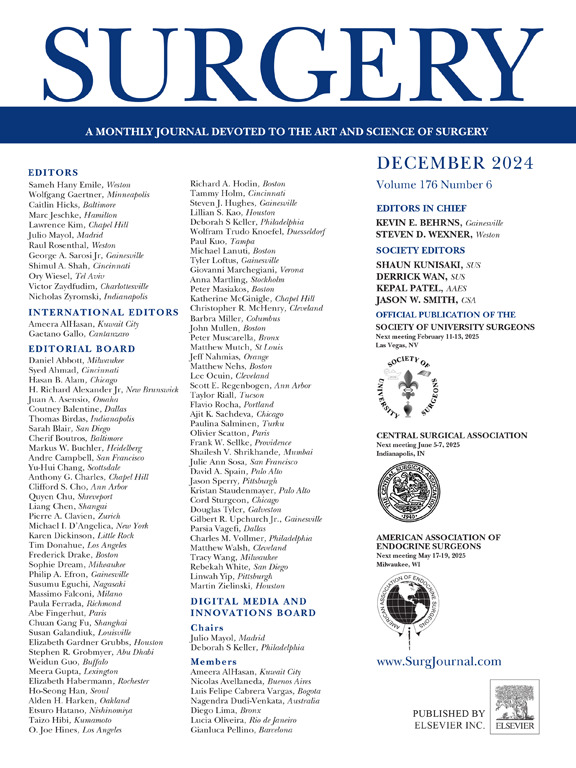四维计算机断层扫描在预测单腺甲状旁腺疾病中的应用-我们能放弃术中甲状旁腺监测吗?
IF 3.2
2区 医学
Q1 SURGERY
引用次数: 0
摘要
背景:四维计算机断层扫描通常用于定位甲状旁腺疾病,有报道称甲状旁腺的定位率一直很好。本研究评估了将四维计算机断层扫描结果与术前临床变量配对是否可以准确预测原发性甲状旁腺功能亢进的单腺体疾病。方法纳入2019年1月至2021年9月在大型学术卫生系统接受4维计算机断层成像和甲状旁腺切除术的原发性甲状旁腺功能亢进患者。收集患者人口统计学、术前特征、围手术期和术后数据。计算四维计算机断层扫描在术前有无钙和甲状旁腺激素水平的情况下正确识别单腺体疾病患者的准确性。术中甲状旁腺激素下降50%,病理上为高细胞腺。结果175例患者有提示单腺体病变的4维ct结果。152例患者(87%)被正确预测为单腺体疾病。术前钙(≥10.5 mg/dL,≥11 mg/dL和≥12 mg/dL)和甲状旁腺激素水平(≥65 pg/mL,≥100 pg/mL和≥200 pg/dL)分层时,预测准确性提高。当按年龄(≤50岁)分层时,准确率进一步提高。当合并以下任何一项时,单个腺体疾病的准确性为100%:(1)钙≥12 mg/dL,(2)甲状旁腺激素≥200 pg/dL,或(3)≤50岁的患者钙≥11 mg/dL。结论单纯四维计算机断层扫描对原发性甲状旁腺功能亢进患者单腺病变的预测准确率为87%。当结合术前钙、甲状旁腺激素和年龄阈值时,单腺体疾病的预测准确率接近100%。考虑到在这些情况下发生单腺体疾病的可能性很高,临床医生可能会考虑在没有术中甲状旁腺激素监测的情况下对选定的患者进行集中的单侧甲状旁腺切除术。本文章由计算机程序翻译,如有差异,请以英文原文为准。
Utility of 4-dimensional computed tomography in predicting single-gland parathyroid disease—Can we abandon intraoperative parathyroid monitoring?
Background
Four-dimensional computed tomography is routinely used to localize parathyroid disease, with consistently excellent parathyroid gland localization rates reported. This study evaluated whether pairing 4-dimensional computed tomography results with preoperative clinical variables can accurately predict single-gland disease in primary hyperparathyroidism.
Methods
Patients with primary hyperparathyroidism who underwent both 4-dimensional computed tomography imaging and parathyroidectomy between January 2019 and September 2021 at a large academic health system were included. Patient demographics, preoperative characteristics, and peri- and postoperative data were collected. The accuracy of 4-dimensional computed tomography in correctly identifying patients with single-gland disease with and without preoperative calcium and parathyroid hormone levels was calculated. Single-gland disease was defined by intraoperative parathyroid hormone decrease >50% and a hypercellular gland on pathology.
Results
One hundred seventy-five patients had 4-dimensional computed tomography results suggestive of single gland disease. One hundred fifty-two patients (87%) were predicted correctly to have single-gland disease. The predictive accuracy increased when stratifying by preoperative calcium (≥10.5 mg/dL, ≥11 mg/dL, and ≥12 mg/dL) and parathyroid hormone levels (≥65 pg/mL, ≥100 pg/mL, and ≥200 pg/dL). The accuracy further increased when stratifying by age (≤50 years). Accuracy for single gland disease was 100% when combined with any of the following: (1) calcium ≥12 mg/dL, (2) parathyroid hormone ≥200 pg/dL, or (3) calcium ≥11 mg/dL in patients ≤50 years.
Conclusion
Four-dimensional computed tomography alone accurately predicted single gland disease in 87% of patients with primary hyperparathyroidism. When combined with preoperative calcium, parathyroid hormone and age thresholds, predictive accuracy for single-gland disease approached 100%. Given the high likelihood of single-gland disease in these scenarios, clinicians may consider offering focused unilateral parathyroidectomy without intraoperative parathyroid hormone monitoring in selected patients.
求助全文
通过发布文献求助,成功后即可免费获取论文全文。
去求助
来源期刊

Surgery
医学-外科
CiteScore
5.40
自引率
5.30%
发文量
687
审稿时长
64 days
期刊介绍:
For 66 years, Surgery has published practical, authoritative information about procedures, clinical advances, and major trends shaping general surgery. Each issue features original scientific contributions and clinical reports. Peer-reviewed articles cover topics in oncology, trauma, gastrointestinal, vascular, and transplantation surgery. The journal also publishes papers from the meetings of its sponsoring societies, the Society of University Surgeons, the Central Surgical Association, and the American Association of Endocrine Surgeons.
 求助内容:
求助内容: 应助结果提醒方式:
应助结果提醒方式:


